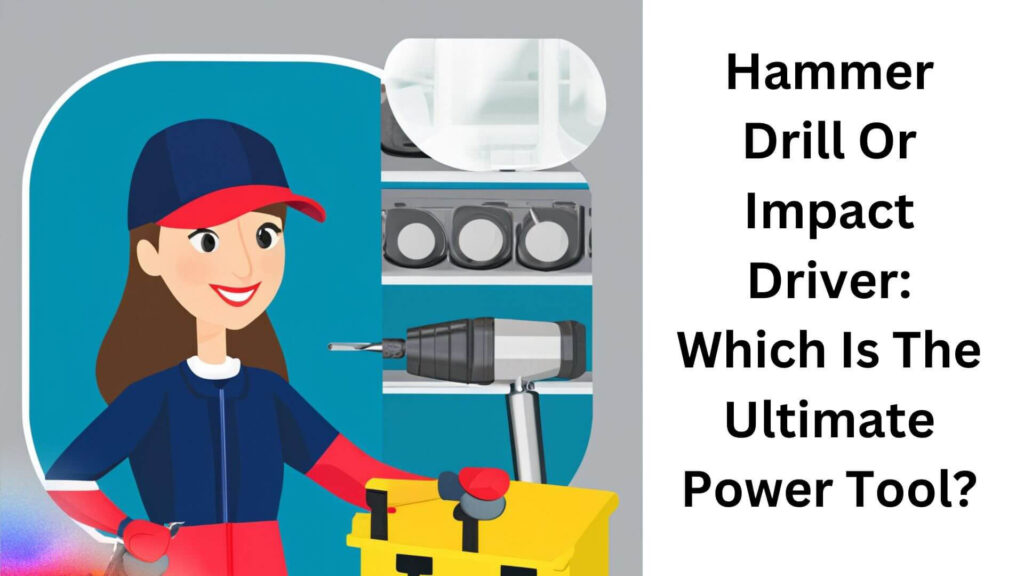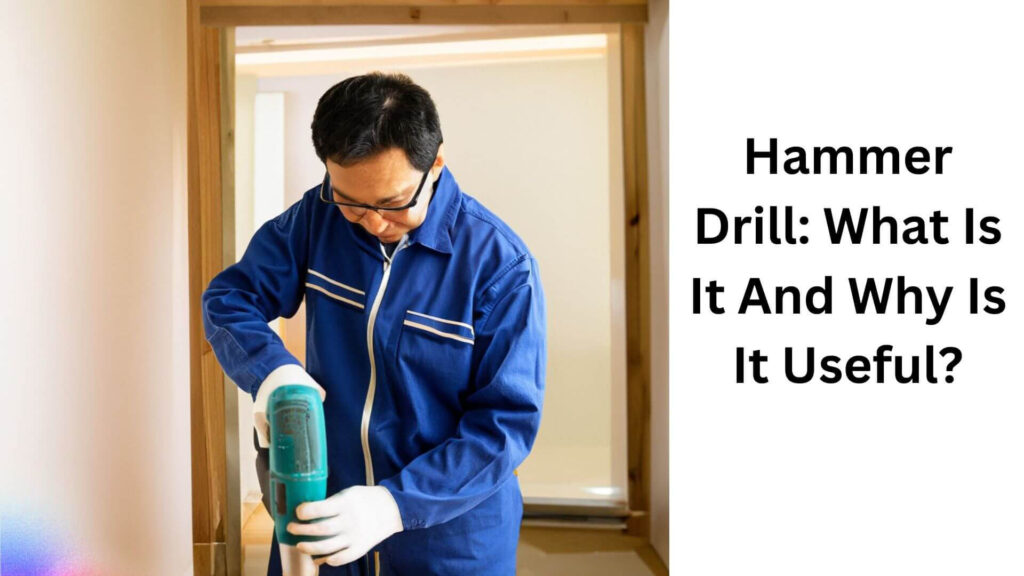No, an impact driver is not the same as a hammer drill. An impact driver is designed for driving screws and bolts with high torque.
On the other hand, a hammer drill is designed for drilling holes into hard materials like concrete and masonry.
While both tools may look similar, they have different functions and capabilities. When working on a diy project, choosing the right tool for the job can greatly affect the outcome.
If you’re looking to purchase a new power tool, it’s important to understand the differences between different types of tools.
This article will investigate the differences between impact drivers and hammer drills. I’ll discuss their function, capabilities, and the types of projects they’re best suited for. By the end of this article, you’ll better understand which tool is right for your next project.
Table of Contents
Hammer Drill Or Impact Driver: Which Is The Ultimate Power Tool?

When it comes to diy projects and home repairs, having the right tool for the job is essential. Hammer drills and impact drivers are two popular power tools that can confuse diy enthusiasts. These tools may look similar, but they are designed for different purposes.
Here I’ll explore the definition and explanation of hammer drills and impact drivers, the differences between the two tools, and which tool best suits specific tasks.
Definition And Explanation Of Hammer Drills And Impact Drivers
Hammer drills and impact drivers are power tools that can drill through wood, metal, and concrete surfaces. However, they work differently.
- A hammer drill uses a rotating drill bit and a hammering function to create holes in hard materials like concrete. The hammering function adds force to the drill bit, allowing it to break through the surface.
- On the other hand, an impact driver applies torque in short, powerful bursts to drive screws into surfaces. Impact drivers use a collet instead of a chuck, which can hold hexagonal screwdriver bits and drill bits with hex shafts.
Differences Between Hammer Drills And Impact Drivers
The main differences between hammer drills and impact drivers are:
- Purpose: Hammer drills are designed for drilling holes in hard surfaces like concrete, while impact drivers are best suited for driving screws into surfaces.
- Speed: Impact drivers have a higher rotational speed than hammer drills, which gives them more torque and makes them ideal for driving screws.
- Chuck: Hammer drills use a chuck that can hold drill bits with straight shanks, while impact drivers use a collet to hold screwdriver bits with hexagonal shanks.
- Force: Hammer drills apply force to the drill bit in a hammering action, while impact drivers use high speed and torque to drive screws.
Choosing The Right Power Tool For The Job
Choosing the right power tool for the job is crucial. However, knowing which tool best fits the task at hand can be hard. Here are some factors to consider before choosing between a hammer drill and an impact driver:
- Material: Consider the type of material you’re working with. Impact drivers work well on softer materials like wood and drywall, while hammer drills are ideal for harder materials like concrete.
- Task: Determine the purpose of your tool. If you’re drilling holes, a hammer drill is the best choice. An impact driver is your tool if you’re driving screws or bolts.
- Power: Consider the power source you have available. If you only have access to an electric outlet, a power corded hammer drill is an excellent choice. If you need a cordless option, an impact driver is the way to go.
Regarding hammer drills vs. impact drivers, it’s no longer a question of which is better. Instead, it’s about which tool is best suited for the job at hand.
Whether you choose a hammer drill or an impact driver, a reliable power tool can make all the difference in completing your diy tasks like a pro.
Read More: 7 Best Impact Driver For Electricians
Hammer Drill: What Is It And Why Is It Useful?

If you’re a diy enthusiast or a professional in the construction industry, you’ve likely heard of the term “hammer drill. ” But what exactly is it, and why is it useful?
Here I’ll provide a clear and concise definition of hammer drills and explain their advantages, disadvantages, and materials they are most suitable for.
- A hammer drill is a powerful and versatile drilling tool that combines the functions of a traditional drill and a hammer. It’s designed to drill into tough materials like masonry, brick, and concrete.
- Hammer drills combine a rapid hammering motion with a rotary drilling motion, ensuring that the drill bit churns through the material much faster than a standard drill.
- The hammering motion is produced by an internal mechanism, which drives a piston back and forth. This piston strikes the back of the chuck, causing the bit to hammer into the material being drilled.
Advantages And Disadvantages Of Using A Hammer Drill
Advantages:
- Hammer drills are ideal for drilling into tough materials like brick, concrete, and masonry.
- They are powerful, efficient, and can complete jobs much quicker than traditional drills.
- Hammer drills are available in both corded and cordless options, which makes them highly portable.
- They are versatile and can be used for various tasks, such as drilling holes for anchors, screws, or dowels.
Disadvantages:
- Due to their design, hammer drills can be loud and produce a lot of vibration. They can also be heavy and difficult to handle, making them less suitable for precision drilling tasks.
- The hammering action can cause the bit to heat up and wear out faster than a traditional drill bit, requiring more frequent replacements.
- Hammer drills are often more expensive than standard drills, making them less accessible for diy enthusiasts and hobbyists.
Read More: Best Budget Hammer Drill
Types Of Materials That A Hammer Drill Is Most Suitable For
- Masonry: Hammer drills excel at drilling into masonry surfaces, such as brick, concrete, and stone. They are perfect for installing anchors, creating holes for plumbing pipes, or mounting shelves and cabinets.
- Heavy metal: Hammer drills also effectively drill into hard metal surfaces. However, using the proper drill bits is essential to avoid damaging the material or the bit.
- Wood: While hammer drills are not ideal for drilling into wood, they can be useful for creating pilot holes or drilling into hardwoods.
- The bottom line is that a hammer drill can make your task much more efficient and effective if you need to drill into hard surfaces like masonry, concrete, or heavy-duty metal.
Impact Driver: What Is It And Why Is It Useful?
There has always been confusion surrounding impact drivers and hammer drills. While both are effective power tools in their own right, they serve very different purposes. In this post, we’re going to discuss impact drivers solely. In particular, I’ll delve into the definition and explanation of impact drivers, their advantages and disadvantages, and the types of materials for which an impact driver is most suitable.
Definition And Explanation Of Impact Drivers
An impact driver is a power tool designed to insert and extract screws. It’s known for its high rotational torque enabling it to apply a significant amount of downward force without stripping the screw.
This makes impact drivers ideal for driving screws in dense materials such as hardwoods, metal, and concrete.
Advantages And Disadvantages Of Using An Impact Driver
Like every power tool, impact drivers have their advantages and disadvantages. Some of the pros include:
- Less physical strain: As impact drivers use rotational force to drive screws, it requires less physical exertion from the user.
- Increased speed: Impact drivers feature a quick-change mechanism, making switching out screws quick and easy.
- Power: Because of its unique mechanism, impact drivers provide exceptional power, often surpassing a standard drill.
Of course, there are also a few cons associated with impact drivers, such as:
- Noise: The high torque of an impact driver often creates a lot of noise, which can be detrimental when working in enclosed spaces.
- Cost: Compared to standard drills, impact drivers can be more expensive, especially considering the additional cost of compatible bits and sockets.
Types Of Materials That An Impact Driver Is Most Suitable For
Impact drivers are best suited for dense materials such as:
- Hardwoods: Hardwoods such as oak, maple, and cherry require a lot of torque to drive screws through the dense wood.
- Metal: You can use impact drivers to insert screws into metal sheets, studs, and frames.
- Concrete: Impact drivers can be used with masonry bits to drill through concrete.
An impact driver is an excellent investment for those who frequently need to drive screws into dense materials. While they have advantages and disadvantages, their unique mechanism and power make them an ideal addition to your power tool collection.
Read More: Can You Use An Impact Driver As An Impact Wrench?
Comparative Analysis Of Hammer Drills And Impact Drivers
Are you considering buying a tool to help you with your diy projects but unsure whether to use a hammer drill or impact driver? Here I’ll provide a comparative analysis of the two tools and offer insight into their use cases.
Advantages And Disadvantages Of Using A Hammer Drill Vs. An Impact Driver
Hammer Drill
Advantages:
- Ideal for drilling into hard materials like concrete, masonry, and bricks.
- It has a clutch that lets you apply more or less power depending on the task.
- Suitable for drilling holes that require smooth finishes.
Disadvantages:
- Not suitable for driving screws.
- Heavier than impact drivers and may cause fatigue during long periods of use.
- The hammering mechanism can sometimes produce more noise.
Impact Driver
Advantages:
- Ideal for driving long screws into tougher materials.
- Has a higher rotational torque than a hammer drill.
- They are lighter and more compact than hammer drills, making them easier to use for longer periods.
Disadvantages:
- Not ideal for drilling into hard materials like concrete, masonry, and bricks.
- It does not have a clutch, so controlling the amount of power applied to the screw is harder.
- It can produce torque reactions, making it difficult to control during use.
Comparison Of The Torque, Speed, And Power Of The Tools
Regarding torque, impact drivers have a much higher rotational torque than hammer drills. On the other hand, Hammer drills have more power, making them ideal for drilling into tough materials. Regarding speed, impact drivers are much faster and can drive screws more efficiently than hammer drills.
Use Cases For Each Type Of Tool
Hammer Drill
- Used for drilling into hard materials like concrete, masonry, and bricks.
- Suitable for drilling holes that require smooth finishes.
- Ideal for tasks that require varying amounts of power, thanks to the clutch mechanism.
Impact Driver
- Ideal for driving long screws into tougher materials.
- Suitable for tasks that require speed, thanks to the higher rotational torque.
- They are more portable and easier to use for long periods, making them ideal for diy projects.
Impact drivers and hammer drills are unique features ideal for specific use cases. A hammer drill is the way to go if you primarily need a tool to drill into tough materials.
However, if you’re looking for a tool that can drive screws quickly or need something lightweight and portable, an impact driver is the better choice.
Factors To Consider When Choosing Between A Hammer Drill And An Impact Driver
Choosing the right one for the job can make all the difference regarding power tools. When deciding between a hammer drill and an impact driver, there are a few factors to consider. Here are some key points to keep in mind when making your decision:
1. Types Of Jobs And Materials
- Hammer drills are ideal for drilling into concrete and masonry, while impact drivers are better suited for fastening screws and driving bolts.
- Hammer drills use a pounding force to break through hard materials, while impact drivers use a rotational force to drive screws and bolts quickly.
- Impact drivers are typically smaller and more compact than hammer drills, making them easier to use in tight spaces or on delicate workpieces.
2. Project Scope And Time Constraints
- If you’re working on a larger project that requires a lot of drilling and anchoring into concrete or masonry, a hammer drill is the way to go.
- If you have a lot of screws to drive quickly, an impact driver is your best bet. They can save much time and effort when fastening screws or bolts.
- If you’re working on a smaller job, such as hanging a picture or assembling furniture, either tool could work, but the impact driver may be the more versatile choice.
3. Personal Experience And Preference
- If you’ve used one tool more than the other in the past and feel comfortable using it, stick with what you know.
- If you don’t have much experience with either tool, consider what types of projects you’ll be working on most often and choose the best tool for those jobs.
- Some people may prefer the feel of a hammer drill over an impact driver, while others may prefer the precision and speed of an impact driver.
Frequently Asked Questions For Is An Impact Driver The Same As A Hammer Drill
Is An Impact Driver The Same As A Hammer Drill?
No, they are different tools with different purposes. Impact drivers are for fastening, while hammer drills are for drilling.
Can You Use A Hammer Drill For Screws?
Yes, but it’s not the best tool for the job. A hammer drill can be used with screwdriver bits, but an impact driver is more efficient.
Which Is Better For Concrete: Hammer Drill Or Impact Driver?
A hammer drill is better for drilling into concrete because it has a hammering function that breaks up the concrete.
What Is The Difference Between A Drill Driver And An Impact Driver?
A drill driver is used for drilling and driving screws, while an impact driver is better for fastening and loosening nuts and bolts.
Do I Need Both An Impact Driver And A Hammer Drill?
It depends on the type of work you do. A hammer drill is essential if you frequently work with concrete, while an impact driver is great for fastening screws and bolts.
Final Verdict
As we have concluded, an impact driver and a hammer drill are different power tools with different functions. Both tools work in different ways and excel in various applications.
Impact drivers have higher torque levels, making them ideal for driving screws, bolts, and long fasteners, while hammer drills have a hammering action utilized for drilling into hard surfaces like concrete, stone, or brick.
Choosing between the two depends on factors such as the type of task and the material being worked on.
Therefore, it’s important to understand the differences before picking one for a particular job. Keeping in mind the differences and in-depth specifications of both tools, one should be able to determine precisely which tool to buy to deliver remarkable results while saving time and effort.
By being aware of the subtle differences between an impact driver and a hammer drill, an informed decision can be made about which tool suits your needs and requirements.

Hey, I am Shihab Uddin, I’m a huge fan of DIY crafts. My workshop is where I spend most of my spare time, and I’m always working on some project. To that end, I’d like to share some of my knowledge and experience with you in power tools, woodworking, and other specialized materials fabrication.
I will guide you with genuine knowledge that can assist you with deciding whether a drill is appropriate according to your requirements or not. If you want to find the best drill and know which type of drill is most suited for your needs, then I can guide you with my expertise. My passion lies in helping others find the correct products they need at an affordable price.


